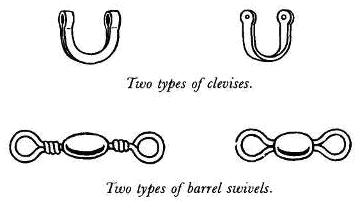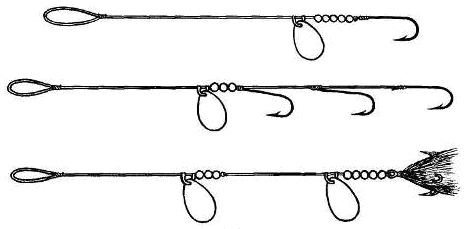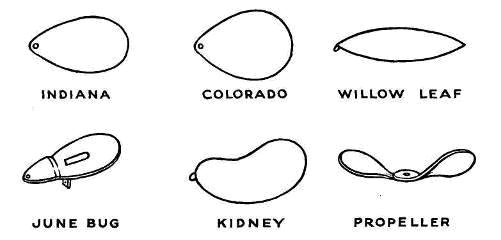|
Fishing SpinnersRevolving Spinners And
|
Instead of solid metal beads you can use body forms made from solid metal to provide the weight. See illustration below. They can be ordered from fishing lure parts suppliers, or you can make your own by obtaining solid brass rods, then cutting them into short lengths and drilling a hole through the center.

Fishing spinners also require clevises, which hold the blade so that it can revolve freely around the wire shaft. There are two types, as shown below. They usually come in two or three different sizes for small and large spinners.

Split rings are also needed in various sizes when making spinners. Barrel swivels such as those shown above are also required in different sizes.
Some of these split rings and swivels can be bought in fishing tackle stores, but you can save money if you buy them in larger quantities such as gross lots from a mail-order house.
Most spinners are used for fish trolling , but they can also be used for fish casting if you add a small clincher sinker or other weight to the leader. You can also get some sheet lead and cut out a small rudder which is then folded over the wire shaft of the spinner in front of the blade. See illustration below.

To keep it from sliding down the shaft, make more turns than usual when forming the eye of the spinner. Then crimp the lead rudder on these turns with pliers.
In addition to serving as a casting weight, the lead rudder also acts as a keel and prevents the spinner from twisting the line. You can paint this lead weight in any color you want and even add an eye on each side.
You can also make special casting or trolling weights which are detachable and can be added to the spinner at the front. See Sinkers on making sinkers for details on how such weights can be made.
Another way to make fishing spinners is to use nylon leader material instead of wire to serve as a shaft. You can buy the nylon material in coils of various diameters and strengths.
Cut off a length, tie a loop for an eye up front, slip on the beads, plus a clevis with a blade, and then tie either a single hook or treble hook on the tail end.
The larger glass or plastic beads are best for this because they have bigger holes through which the nylon leader material can be threaded. If you want the spinner blade to revolve well above the hook, tie knots on the leader to act as stops against which the beads will rest.

The above illustration shows different types of fishing spinners you can make, using the nylon leader material. You can easily work out many of your own combinations.
The saltwater fishing spinners are very similar to the freshwater types. In fact, you can use many of the freshwater spinners for saltwater fishing if you use heavier wire shafts, bigger blades, and stronger hooks.
The fishing spinners described here do not cover every type made. But they are the basic types from which you can go on and make endless combinations of your own.
|
| Freshwater Fishing | Bass Fishing | Saltwater Fishing | | Fishing Spoons | Fishing Spinners | Fishing Jigs | | Sinkers | Making Fishing Leaders | Hand Tools | | Link To Us | Contact Us | Preferred Partners | About This Site | | Site Map | |
| Back to Top |
Make-Your-Own-Fishing-Lures.com
© 2004 Make-Your-Own-Fishing-Lures.com. All Rights Reserved.




